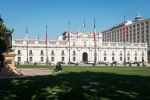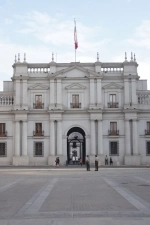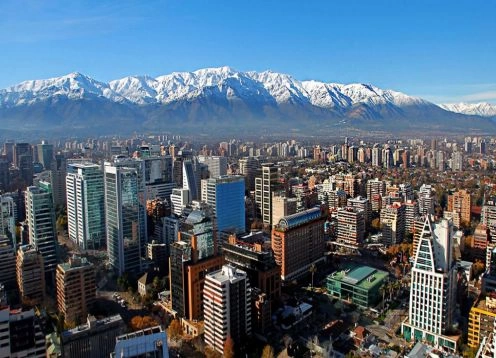La Moneda Palace (Goverment palace), Santiago. Santiago - CHILE
Direccion:
Moneda S/N, Santiago. Esquina Alameda The story begins in 1732 the palace when the Cabildo of Santiago asks the King of Spain for permission to install a mint so the problem of currency shortage that occurred when from Peru was delayed shipment of coins.
As the Crown did not have the resources, we decided it was an individual who assumed the installation of the factory shall be provided with tools, operators and paid to buy the metal for coinage in return was given the position of Treasurer and Perpetual usufruct of the profits of the coinage, privileges that would be inherited to their offspring. It was the Spanish merchant, Francisco Garc?a Huidobro (Relative of CEO Ruta Chile) who acquired the house of the southwest corner of Orphans and Morande, known as the Old Palace and currently occupied by a branch of the State Bank. On September 10, 1749 in that place, first minted in gold coin with the image of King Ferdinand VI.
After the death of Garcia Huidobro, the Mint is moved to the old college of St. Michael, a Jesuit school located next to the church of the Company. The facility did not meet the conditions required, so that in 1780 the Governor proposes to construct a building for that purpose. The chosen for the project was the Roman architect Joaqu?n Toesca and Ricci, who had come to Santiago to conclude the work of the Cathedral.
As the most suitable site, the College chooses Toesca Carolino then known as the site of the Theatines there for having installed a house of religious giving name to the street. Thus, the works begin in 1784. Toesca could not see his work finished, as he died in 1799, and its work was continued by the military engineer Augustine Cavallero. In 1805 and missing some endings, Governor Munoz de Guzman opened the Royal Mint of Santiago de Chile, considered one of the best and most harmonious civil buildings of colonial America.
After the president Bulnes, who was making repairs in the building affected by the earthquake of 1850, President Manuel Montt had to face a major fire in 1855. The palace is divided into three sectors: the presidents residence, seat of government and mint, which continued to occupy the south sector of the building with their furnaces, fireplaces and boilers.
Presidents Jose Joaquin Perez, Federico Err?zuriz Za?artu quiseron not live in the palace. President Pinto lived in the palace and he went from the main operations of the Pacific War. His successor, President Santa Maria did not inhabited the palace.
President Jos? Manuel Balmaceda lived in the palace, and made numerous changes to it, becoming completely remodeled, equipped with several advances in time and redecorated in the sectors for official receptions. It is roofed with a metal frame the courtyard of the Presidency and decorated the famous Red Room. At that time the eldest son of President Pedro Balmaceda Toro, regularly received some intellectuals in his room at the Palace among which the Nicaraguan poet Ruben Dario.
The building has undergone several changes that began with the presidency of Ram?n Barros Luco. The environment of the palace underwent a major refurbishment since 1930, which gave prominence to its south facade, was the plazas on both fronts and surrounded the palace of austere buildings that would give rise to current civic district. From this period is the transfer of the facilities of the Mint to its present location in the Quinta Normal. In 1906, President Pedro Montt Montt had opened the door Morande 80.
The main facade to the square of Moneda Street was facing a large space, which was called Plaza de la Constitution, then demolishing the old building that occupied the headquarters of Dragons.
The southern part of the palace was remodeled in 1929 and in 1935 to provide a way out of Alameda, inventing a facade that did not exist in the original building. During the presidency of Juan Antonio R?os row was demolished Coinage and Balance, which was part of the draft Toesca, replacing the so-called "Patio de los Naranjos".
Following the bombing of 1973, the Palacio de La Moneda, was left with serious structural damage and restoration completed in 1981. The Palace again became the seat of executive power between 81 and 88. With the return to democracy had to be re-adorned as the occupants leave the building almost dictatorship was dismantled.
During 2000, the main facade was restored and then the entire building, giving it a matte white finish.
In September 2003, 30 years later, Morande mythical gate 80 would be reopened by President Lagos. Lagos was also the president who restored the tradition established by Frei allow public access to the courtyards of the Palace of Government.










 114 Reviews
114 Reviews